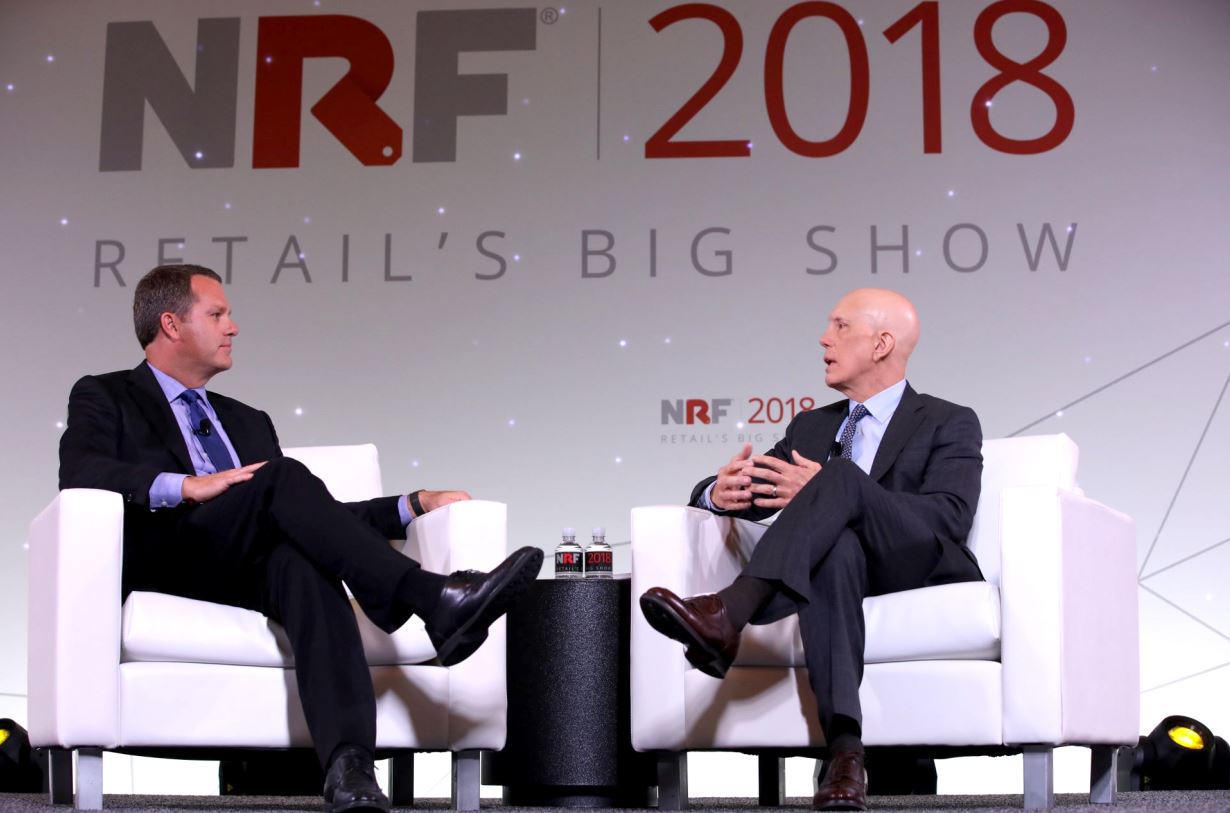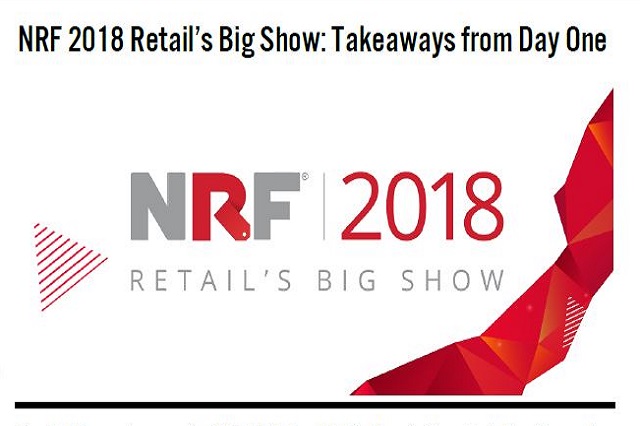1) Intel demonstrated several solutions—not products—for retail, all of which are based on data.
At NRF 2018 Retail’s Big Show, Intel showcased several technologies, all of which were offered by other vendors. Data was the theme of Intel’s presentation at last week’s CES 2018 trade show in Las Vegas, and its efforts this year are focused on helping companies manage the flood of data produced by cameras and sensors of various types. Intel has invested $17 billion in developing Internet of Things (IoT) products and it seeks to increase its return on this investment by deploying those technologies across industries, including in retail. Intel’s wide and deep view of the technology landscape enables it to advise companies on technologies and solutions, acting as a matchmaker. Companies then purchase products and services from third-party providers whose equipment and solutions contain Intel components and technology.
Users of Intel’s retail technology include China’s JD.com, which is using Intel technology to create an automated store format called D-Mart. In its exhibition booth at Retail’s Big Show, Intel demonstrated a retail shop that uses its technology to track visitor and demographic information that can be used to create traffic patterns and heat maps. Candy retailer Lolli & Pops demonstrated Intel-based facial recognition technology that is used for customer identification and loyalty purposes. The Intel booth also featured shelf-stock management and display systems and Bossa Nova robots, which can monitor on-shelf inventory.
 Smart-shelf technology on display at the Intel booth
Source: FGRT
Smart-shelf technology on display at the Intel booth
Source: FGRT
2) Factoring weather data into decisions can help companies forecast more accurately, reduce inventory, increase efficiency and raise net income, according to Planalytics and JDA.
Planalytics and JDA gave a joint presentation titled “Show Me the Weather” that highlighted the benefits of incorporating weather data into retail forecasting and planning. The inclusion of Planalytics weather analytics on JDA’s demand-planning platform occasioned the joint presentation. An executive from JDA outlined the challenge of predicting consumer demand and discussed the benefits of analyzing social, news, events and weather big data.
Evan Gold, EVP of Global Services at Planalytics, distinguished between weather data and weather analytics, which can be used to determine weather-driven demand. Gold said that retailers must first deweatherize retail sales data, i.e., adjust the data to remove weather-related-demand factors, since weather repeats only 15% of the time. This adjustment leaves retailers with a weather-neutral baseline. Then, retailers must add back in forecast upcoming weather impacts. Planalytics claims that this process results in an accuracy improvement of 82% in subclasses, as well as an increase of two to five percentage points in net income, which is highly significant for retailers. Using weather data can help retailers improve forecast accuracy, reduce stock and inventory carrying costs, and ensure consistency and scalability, Gold said. It also provides other benefits in terms of marketing, labor planning and replenishment.

Slide from a Planalytics and JDA presentation detailing how retailers can use weather data to improve forecast accuracy
Source: FGRT
3) Walmart still views retailing as a people business and the company continues to feel the presence of its late founder, Sam Walton.
NRF President and CEO Matthew Shay interviewed Walmart CEO Doug McMillon on the first day of the trade show. The conversation touched on a number of topics, ranging from McMillon’s start with Walmart to how the company is maintaining its values despite a period of rapid technological change.
McMillon said that he began his career with Walmart by working in a company warehouse, which led to stints in the stores and, ultimately, to the home office. He will likely be the last Walmart CEO who actually worked with the company’s founder, Sam Walton.
Much of the discussion centered on employee issues, particularly the company’s recent announcement that it would grant employee bonuses and maternal and parental leave to certain employees. Regarding e-commerce and Walmart’s Jet.com acquisition, McMillon said, “Although we have become a different kind of tech company, the people in the process will be the way we can win.” He noted that the company is using various technologies, including virtual reality, in its 200-plus academies to help staff develop their skills.
McMillon confessed that Walmart had initially “missed the memo” on social issues, but that the company had then started listening to its critics. The retailer’s environmental and social efforts now include a goal of reducing its carbon footprint by 1 billion tons. Regarding the company culture, McMillon said that although Sam Walton passed away in 1992, his presence is still felt throughout the company and that all Walmart employees know that the only constant within the company is change.

Walmart CEO Doug McMillon (left) is interviewed by NRF President and CEO Matthew Shay
Source: NRF Retail’s Big Show
4) Instagram is increasingly becoming a platform through which businesses can connect with consumers.
Instagram is increasingly becoming a platform through which businesses can engage with consumers for marketing and product development purposes. More than half of Instagram’s 800 million users connect to businesses voluntarily via the platform. Since the introduction of the Instagram Story feature, a third of the most-watched Stories have been uploaded by businesses.
Tyler Haney, Founder and CEO of activewear brand Outdoor Voices, said that his company has built a successful Instagram strategy by actively seeking customer opinions via Instagram throughout the product development process, a strategy that few retailers use. J.Crew and New Balance are among the brands that have utilized the “poll” Sticker feature on Instagram to collect customer feedback, said Marne Levine, Instagram’s COO.
5) In e-commerce, international retailers are gaining advantages in terms of customer experience rather than price.
Speakers from Via Varejo, Brazil’s largest nonfood retailer, and Italian apparel retailer Calzedonia Group shared their e-commerce priorities. Both companies are seeking to offer better customer experiences through improved click-and-collect features, deliver better personalized marketing messages to multichannel shoppers and reduce delivery time for customers. Calzedonia is already able to offer two-day delivery in some key European markets. Matteo Molon, Calzedonia’s Head of E-Commerce and CRM, stressed that the company’s goal is to compete on services, not price, in e-commerce.
Look for our continued coverage of NRF 2018 Retail’s Big Show this week.

 Smart-shelf technology on display at the Intel booth
Source: FGRT
Smart-shelf technology on display at the Intel booth
Source: FGRT
